Category: Digital Transformation
Today, how you and I use technology for work and life has dramatically changed. Each year brings with it innovations and trends that have the potential to revolutionize industries and reshape our daily lives. As Leaders, IT professionals and companies, we are focused on technologies that will help us reduce further investments and acquire more returns.
In 2023, several technology trends have emerged that hold significant promise for transforming various sectors. This year began with renewed vigour and enthusiasm for adopting technologies that will be worthwhile for accelerating business performance.
In this blog, we will delve into eight technology trends you should consider this year.
Recently, one new trend that has been making waves in the tech world is Generative AI. It promises to drive sustainable growth, solve global challenges, and transform business operations significantly. Generative AI is the upgraded version of AI, which adds to the innovative capabilities of existing technologies like applied AI and industrial machine learning.
A June 2023 report by McKinsey titled The Economic Potential of Generative AI: The Next Productivity Frontier states generative AI and related models have transformed how businesses will use AI in the future.
For a better perspective, you can read our blog on privacy and security concerns on Generative AI.
Generative AI upgrades components within assistive technology by accelerating application development and making powerful capabilities available to the non-technical user base.
By looking at the latest predictions, we can deduce Generative AI is likely to add $4.4 trillion in economic value by harnessing specific use cases and other diverse uses like drafting email templates to increase overall productivity.
Although we have not seen significant tech investments over the past year, we can remain optimistic about future growth investment prospects. The year 2022 witnessed almost $1 trillion in tech investments, cementing our faith in the value potential of trending technologies.
Despite witnessing a decline in the adoption and uptake of applied AI, advanced connectivity, cloud, and edge computing, we can conclude that it is partially due to their maturity levels. Mature technologies are often exposed to short-term budget dynamics more than recent ones, such as climate and mobility technologies.
One example would be Open AI, which is predicted to go bankrupt by the end of 2024. The operational expenses for Open AI amount to $700,000 per day. Despite experiencing robust success initially, these financial struggles are hindering the company from achieving a revenue level that covers crucial expenditures.
Despite much noise about trending technologies, we must primarily focus on the value and potential of relevant technologies for our business progress. With a careful assessment of emerging landscapes and a balanced approach towards old and innovative technologies, we can harness innovation for sustainable growth.
Let us look at the current and upcoming trends around relevant technologies that tech companies should watch out for.
1. Applied AI
- AI models trained in machine learning can help streamline numerous mundane tasks. They can help segregate data, forecast predictions, and address automation issues for prompt and effective decision-making.
- From natural language processing (NLP) powering advanced chatbots and virtual assistants to AI-driven drug discovery and predictive analytics, AI is reshaping industries and enhancing decision-making processes.
- In 2022, we witnessed significant equity investments towards Applied AI worth $104 billion.
2. Automating Machine Learning
- The constantly emerging world of software and hardware technologies is expediting and eliminating risks involved in automated machine learning.
- In 2022, Machine Learning Automated solutions secured equity investments worth $3 Billion.
3. Generative AI
- Generative AI possesses capabilities that accelerate business operations significantly. The technology helps automate and expedite tasks by harnessing unstructured mixed modality data sets to help generate the latest content. Generative AI can use data sets to produce brand-new text, video, and code, among other things.
- In 2022, Generative AI secured equity investments of $5 Billion.
4. Next-Gen Software Development
- The latest software development tools possess capabilities to enhance application quality and accelerate the development process. These new tools can generate modern code deployment pipelines, automate code generation, and undertake testing, refactoring, and translation.
- One example is the new AI coding partner, the Git Hub Co-pilot tool that generates and refines the code you are working on. It helps solve problems, write tests, and explore new APIs without extensive search. It adapts to your coding method and accelerates the entire process.
- It uses OpenAI Codex, to gain context from written code, and then suggests new lines of code or overall functions.
- Low Code-No Code democratizes software development by accelerating the creation of prototypes, minimizing the development cycle, and fostering collaboration between technical and non-technical teams.
- In 2022, Next Gen Software Development secured equity investments of $2 Billion.
For a detailed insight into Inovar’s Low Code/No Code practices and approaches, download our exclusive whitepaper resource by clicking here.
5. Digital Trust Architecture and Identity
- Digital Trust solutions help companies establish and uphold customer trust; while using their data, digital products, and services.
- Digital trust architecture and identity management play pivotal roles in ensuring secure transactions, safeguarding sensitive data, and providing users with a seamless experience. As technology continues to evolve, so will the strategies and tools employed to build and maintain digital trust.
- Gmail has been attempting to eliminate phishing attacks by incorporating machine learning. If an email appears to be suspicious or a phishing attempt, Gmail will analyze and delay it as a part of its early phishing detection mechanism. Google has been able to intelligently incorporate AI that promptly detects malware and ransomware messages and blocks them immediately.
- The AI-powered Microsoft 365 Defender creates a defensive layer of protection to prevent active threats. It forms a parameter of inspection across numerous security data points like user accounts and end points and isolates the infected entity to prevent widespread impact. It mitigates both horizontal and vertical side-channel attacks.
- In 2022, Trust Architectures secured equity investments of $47 billion.
6. Cloud Computing Services
- Cloud and edge computing distributes work across multiple locations like hyper-scale remote data centres, regional centres, and local nodes to enhance latency, improve data transfer expenses, ensure data sovereignty regulations are complied with, and autonomy over data and security are adhered to.
- This trend is essential for applications like the Internet of Things (IoT), where real-time analysis is crucial. Edge computing also reduces the strain on centralized cloud systems.
- In 2022, Cloud Computing witnessed $84 Billion worth of equity investments and secured an adoption score of 4.
If you are considering migrating to the cloud, download our Cloud Migration Guide.
7. Cybersecurity
- Cybersecurity will witness exponential growth of approximately $198 billion in 2025. In the latter half of 2023, cybersecurity professionals will adopt a zero-trust approach towards external data as cybercrimes grow. AI will be a primary component to defend against cyberattacks.
- Cybersecurity is evolving with more advanced encryption methods, biometric authentication, and AI-powered threat detection. Protecting digital assets and sensitive information has become more critical in current times.
- According to the EU Agency for Cybersecurity, the ransomware business model has seen tremendous growth in the last ten years, and its projected expenditures will exceed $10 trillion by 2025.
Download our Security Case Study that we implemented for a large non-profit education organization.
8. Internet Of Things
- The year 2023 has witnessed more than $650 billion in investments in the Internet of Things, with $315 billion from Smart cities and $335 billion from industrial Internet.
- The technology sector will continue to grow despite economic constraints, compelling businesses to streamline their IoT (Internet of Things) expenditure to devices that offer significant ROI.
Download our IoT whitepaper to check on scenarios you can implement for your business.
Trending technologies of 2023 are the result of the rapid pace at which technology and innovation are evolving. From AI-driven upgrades to finding suitable solutions and upcoming technology patterns, these trends will change how we work, interact, and succeed in this digital landscape.
Technology experts believe 2023 will probably be an exhilarating year for witnessing rapid technological advancements in terms of new tools, their diverse capabilities and how businesses will leverage them to tackle bottlenecks and changes.
The selection and adoption of relevant technologies will pave the direction for the success of several industries in the future.
For more understanding of 2023 Cloud Native Trends, please refer to our informational video on Top Cloud Native Trends to Watch in 2023.
References:
- McKinsey Technology Trends Outlook 2023. (McKinsey Report)
- Introducing GitHub Copilot: your AI pair programmer. (GitHub)
- OpenAI might go bankrupt by end of 2024, ChatGPT costing over Rs 5.80 crore per day. (Business India Report)
- Gmail is bringing in AI security for where humans fail. (CNET)
Robotic Process Automation (RPA) has transformed how businesses automate repetitive manual tasks, enhance productivity, and optimize various operations. These compelling factors have driven many company leaders to hire more RPA developers in recent years.
A study by Precedence Research predicts Robotics Process Automation Investments are expected to reach USD 23.9 billion by 2030. (1)
With a plethora of RPA tools available in the market, the onus of choosing the right tool lies with organizations. So, how do you choose the right one to streamline your process automation services? Let us take a look at Gartner’s Magic Quadrant landscape for Robotic Process Automation to help you make more informed decisions around RPA vendors.

Leaders
Gartner’s Magic Quadrant provides a qualitative analysis of RPA vendors based on their ability to execute and completeness of vision. The four quadrants of this landscape are-
- They have strong execution capabilities and vision and are well established in the market. They have a successful record of accomplishment in terms of implementations and customer satisfaction.
- NICE, Microsoft, Automation Anywhere, UiPath and SSC & Blue Prism are key leaders who have been successful in their RPA executions.
Challengers
- Challengers are vendors who may possess strong execution capabilities but fall short in delivering a comprehensive vision for the future or innovation in their offerings.
- WorkFusion is one such vendor that has been lingering on the border between Leaders and Visionaries for the last three years.
Visionaries
- Visionaries are innovative and forward thinkers, who may experience discrepancies during execution. They have minimal RPA market presence.
- Pegasystems, SAP, Appian and Salesforce are a few RPA vendors who fall under the “visionaries” category as per Gartner.
Niche Players
- Niche players have a narrow vision and focus, minimal market presence or may still be in the initial stages of development.
- Samsung SDS, Cyclone Robotics, Nintex, IBM and Laiye are among the niche players with limited presence in the Robotics Process Automation market.
Despite these factors, we would advise you to consider the unique needs and requirements of your organization when using the Magic Quadrant to choose RPA vendors. To help you in this quest, we will take you through a list of pros and cons of these RPA tools to make your selection process simple.
Let us delve into UiPath first:
- UiPath is a renowned tool in the RPA industry and boasts a robust set of features that makes it a favourite among all organizations.
- It is a tool for end-to-end automation. It provides augmented governance capabilities, developer-friendly user experience, improved computer vision and cloud-orchestrated RPA as a service.
PROS:
1. User-Friendly Interface– UiPath provides an intuitive user interface, making it accessible to technical and non-technical users. Its user-friendly interface speeds up the automation implementation process in cloud and on-premises architecture.
2. Product Strategy– UiPath is renowned among RPA clients. It gives way to an integrated low-code platform with enhanced capabilities like IDO, process mining, cloud delivery and PaaS. It caters to a broad range of roles within the process automation lifecycle including IT staff, business techs and integrated teams.
4. Process Mining– UiPath is a powerful tool worth its price. It independently operates to identify the best automation candidates and provides extensive discovery results.
CONS:
1. Price Point– Its powerful capabilities come with a higher price tag, making it less accessible for smaller businesses with limited budgets. However, UiPath provides a simplified starter package for new customers, which may reduce the cost of entry for customers.
2. Automation Capabilities– Although UiPath has numerous capabilities, many competitors are entering the current market that exceeds or matches these features, especially in complex orchestration, decision automation and case management.
Now let us take a look at Power Automate-
- Power Automate is Microsoft’s entry into the RPA landscape. As part of the Microsoft Power Platform, it integrates seamlessly with other Microsoft products and services, such as Office 365 and SharePoint.
- After being listed in the “Visionaire” category in 2020, the demand for Power Automate has rapidly gained momentum, promising accelerated growth.
PROS:
1. Native Integration: If your organization relies heavily on Microsoft tools and applications, Power Automate can be an ideal choice due to its seamless integration with the Microsoft ecosystem.
2. Pricing Flexibility: Power Automate offers various pricing plans, including a free tier , which makes it more attractive for smaller businesses and those looking to start their automation journey without a significant financial commitment.
3. AI Capabilities: Power Automate leverages Microsoft’s AI capabilities, such as AI Builder, to enable more advanced automation scenarios with natural language processing, image recognition, and more.
Microsoft Power Automate Process Mining with integrated generative AI aims to boost productivity with greater process insights, minimized complexity of processes and consistent process improvement with automation and low code applications.
CONS :
1. UX Factor– Businesses and IT users may find it tedious and perplexing to constantly navigate between Teams, PAD and Power Automate.
2. Learning Curve for Non-Microsoft Users: Users unfamiliar with the Microsoft ecosystem might have difficulty adapting to its interface and functionalities.
What To Choose?
- The choice between UiPath and Power Automate depends on the organization’s specific requirements and priorities.
- If a business requires high-level automation with complex processes and has the budget to invest, UiPath is the better option.
- On the other hand, if businesses work extensively with Microsoft products, and require a cost-effective solution, with moderate automation capabilities, Power Automate might be the right fit.
Lastly, UiPath and Power Automate are powerful RPA tools with a unique set of strengths. It is essential to assess the organizational needs, conduct a thorough evaluation, and even consider running a proof-of-concept to determine which one of these tools aligns best with the business automation goals.
For more insights on Power Platform functionality, please refer to our detailed white paper on Power Platform Automation.
The need to automate workflows and integrate data across applications is essential for organizations’ high productivity. Microsoft PowerApps allows businesses to seamlessly build apps and eliminate manual tasks with automation. PowerApps pre-built templates enable build custom apps, importing data into apps from various data sources, and sharing the app across the organization.
How PowerApps transform day-to-day operations?
Sales Appointment Management – enhances workforce collaboration, and access to sales information, and analyzes customer requirements for future engagements.
Product Orders Management – efficient management of product orders, approvals, and rejections.
Leave Management – streamlines day-to-day management of PTO (Paid Time Off) and attendance.
What does PowerApps offer?
Easy to use tool for Business Users to create and connect apps to both cloud and corporate APIs that can be easily shared amongst others within the organization.
Easily build Web and Mobile Apps for your business that integrates Single Sign-On (SSO) to corporate data and services
Complete security access management using any existing corporate API with Azure Active Directory integration.
Rapid creation of Apps using CRUD APIs for many popular, third-party services in the cloud, as well as on-premises services
Full capabilities of Azure App Service – Can host as many Web, Mobile, Logic, and API Apps as your business needs within the fully managed App Service Environment.
PowerApps use cases
1. Event management app that helps end-to-end management of marketing events.
2. Product information repository to help share access to stakeholders.
3. Field service management is a dynamic app that is featured to address specific organizational needs according to service or product.
4. Global contact management and internal communications platform for effective communications.
5. Tracking financial needs through express management, invoice processing, payments tracking, and financial reports.
6. Optimising operational efficiency with customer/employee self-service portals, partner portals, and supply-chain management apps.
Benefits
1. Automates mundane business processes & manages technology debts.
2. High integration of data across 200+ data sources.
3. Boosts productivity, and efficiency, and enables greater flexibility.
4. Ensures security & allows administering data policies, user control options, and permissions.
5. Do more with the budget, time, and resource constraints.
How we can help!
Inovar-Tech works with clients across industries like Manufacturing, Insurance, Healthcare, Telecom, Retail, Education, and State Governments.
We develop solutions for businesses to address their problems with Data Migration, Process optimization, Automation, Analytics, PowerApps, SharePoint portals, etc.
Talk to us to know more about our use cases and the solutions we provide!
Microsoft adds yet another powerful feature to the low-code/no-code PowerApps. An AI-powered Express Design that can convert any uploaded PDF, PPT, Figma files, hand-written sketches, or screenshots into a working app. Industry-leading AI is built into Express Design that allows seamlessly scanning inputs to produce working apps that can connect to various data sources.
How Express Design works?
1. Upload any files like PDF, take a pic of a hand-written note, a UI screenshot from another app, etc.
2. Power Apps’ inbuilt AI engine trained to recognize common application elements will automatically detect the upload and start generating a working app along with data schema in MS Dataverse
3. Edit this AI-generated app to suit your needs and add more elements
4. Next, integrate with databases like SAP, HubSpot, Salesforce, SQL, etc.
5. Customize the app further with your desired colors, user interface, etc.
Industry-wide use cases
1. Legacy data in various electronic formats which are lying in outdated libraries across many organizations
2. Conference room brain-storm sessions to startup ideas
3. Business function-specific requirements that need to be automated
4. Integration with Figma which enables using the same design with PowerApps Figma UI Kit
5. Interactive educational apps that can be used across a university
Benefits of Express Design in PowerApps
Being true low-code tool PowerApps’ addition of Express Design takes the low-code methodology a step further by enhancing the ease of creating business apps.
This flexibility and ease of creation give organizations the ability to democratize app creation for a specific need by a specific function/department without having to entirely depend on IT.
It also drives organizations to create individual and organizational governance policies along with encouraging innovation by design where ideas are converted, preserved, and shared across the organization fueling growth.
How we can help!
Inovar-Tech works with clients across industries like Manufacturing, Insurance, Healthcare, Telecom, Retail, Education, and State Governments.
We develop solutions for businesses to address their problems with Data Migration, Process optimization, Automation, Analytics, PowerApps, SharePoint portals, etc.
Talk to us to know more about our use cases and the solutions we provide!
In this era of Digital transformation, industries have enhanced their attempt to optimize business processes excelling through Microsoft Power Automate. Many companies are on a spree to trigger platforms like Microsoft Power Automate, Power BI, Power Apps, Power Virtual Bot, SharePoint, Microsoft Teams, and many more. Among which Power Automate is a tech-stack promising platform that boosts productivity and improves business process efficiency by saving time and cost.
The main backbone of any organization is the business processing unit. With the help of business process automation (BPA), companies achieve at the time spent in manual processing, any human errors made, and inefficiency of systems. Statistical analysis proves that with the help of BPA the markets are ballooning at a rapid increase of 10% every year.
What is Microsoft Power Automate?
Microsoft Power Automate formerly known as Microsoft Power Flow is a cloud-based service also known as a low-code or no-code automation tool, built specifically for workflow and process automation. It includes powerful Robotic Process Automation (RPA), called UI Flows, that allows quick and easy automation instead of time-consuming manual processes.
Companies leverage their platform by seamlessly using the Microsoft office 365 services
- To increase their productivity
- Reduce operational costs, and
- Enhance business process efficiency
Ways organizations can use Power Automate
- Create your own workflow
- Automation recurring, frequent, and routine tasks
- Automate legacy of business processes
- Automate cloud applications and databases
- Design logics for Power Apps
- Automate the central business workflow
Benefits of Power Automate in improving Business Process Efficiency
BPA can significantly alleviate many pain points that organizations are facing today. Implementing and installing the right flows can result in achieving key benefits like reduced workload, operational cost, and human errors while increasing compliance and reliability with optimized performance.
1. BPA significantly balloons the productivity of the business process with varied types of workflow automation like Process flow, Desktop flow, Cloud flow according to their need.
2. All the flows can be connected to the process across Microsoft applications like SharePoint, Business Central, Outlook, Facebook, Twitter, etc. These flows well align with the primary aim of Microsoft Teams where the tools make the process more efficient and easily accessible.
3. Power Automate helps create calendars, manage tasks and time, directly from their emails or Teams chats.
4. Process flows are data-centric with many sources applied for numerous purposes. As data collection is time-consuming and missed data may render errors the process automate helps recover this flaw whenever it is triggered.
5. With Power Flow Automate templates, time can be saved by abrogating manual tasks increasing efficiency. While editing these templates or an original process flow, it creates dynamic content options, catches, and identifies errors with the flow checker, and points to the exact need for attention.
Need of Power Automate in different industries
Power Automate has a significant impact on almost every business sector where flows play a vital role. BPA brought revolutionary changes in many sectors like the Healthcare industry, Manufacturing industry, Retail industry, Finance industry, etc. Significantly digital transformation in industries has witnessed adoption to modern technologies including, cloud, AI, IoT, and RPA.
Just like Inovar helped one of the giant US healthcare organizations to manage their COVID 19 registration through an online application. The applied analytics makes the process smooth with Bots and SharePoint, thereby helping staff to access and manage bulk patient information in just one click.
Similarly, the Financial Services and Banking institutions have rapidly adopted business process management automation solutions. With Microsoft Power Automate, the Financial Service sectors can automate loan processing, account opening, customer data management, and details of staff. The manufacturing and retail industry also implements a similar process as the healthcare and finance sectors.
As service consultants, we understand that the automation of industries varies, and every business has its own business goals and capabilities. Hence, keeping them in mind we build solutions that help improve businesses efficiency with Microsoft Power Platform. Discover more about Power Automate with Inovar.
Robotic process automation or RPA has the power and capability to help organizations increase their output and accelerate their digital transformation agenda. The true benefit of RPA rests on the technology’s ability to increase efficiency while reducing costs. There is no surprise that RPA is gaining traction in the market by taking away repetitive manual tasks from the human workforce and freeing them to focus on more critical strategic functions.
6 steps to use RPA in an effective way
1. Identify the process
The first thing is to carry out a thorough assessment of all the operations, within and across various departments, so that you can determine which processes can prove to be good candidates for automation.
2. Manage expectations:
Implementation of RPA is all about managing the people and their expectations. Employees must be informed about the need for automation, its essentiality, and how it is likely to influence the return on investment (ROI). The most important areas in which you need to manage expectations are:
- Implementation time
- Implementation cost
- Cost savings
- Benefits of analytics
3. Choose the right tool
Another vital task is to have a crystal-clear set of objectives that your company aims towards. There you can follow two criteria. First, you can consider vendor-related criteria, such as their experience or their orientation to future-proof automation solutions.
Another way, you can try to match the RPA software features, like security and screen scraping capabilities, ease of implementation, the total cost of ownership, etc., to your company’s hierarchy of goals and needs.
4. Assessment of ROI
A fine-grained analysis is required for analysis of the feasibility required before successful RPA implementation. It is important for every organization to compare investment against return, and to decide based on this to what extent it is profitable to invest in RPA.
5. Involve your IT team
The members of your IT team can provide critical insight as you choose an RPA tool that meets your business objectives. Their expertise will also be valuable whenever unexpected issues or malfunctions occur. Training for other employees will be also easy with their support.
6. Measuring the performance
Finally, formulate key performance indicators (KPIs) based on which you can find out the success rate of your RPA implementation.
Inovar blends diligence with skill
Inovar delivers state-of-the-art smart solutions by blending diligence with skills. We adhere to the aforementioned steps and identify what processes/functions need to be automated.
Considering the massive importance and benefits of RPA solutions in reducing efforts, improving customer service, and increasing profits, proper implementation becomes pivotal to ensure that every step is duly scrutinized, vetted, and backed.
As the world is moving to Industry 4.0 standards and some countries formalizing these standards, workflow automation is going to play a central role as a driving force for telecom organizations. Workflow Automation reduces the time and costs it takes to activate and provision services, thereby increasing the acquisition of end-users.
Workflow Automation
Huge traffic and signal compliance create difficulties to collaborate with peer networks, understand their difficulties, and reach out to the right contact network for a possible solution.
SharePoint resolves the problem of seamless collaboration and communication between internal stakeholders – different teams, departments & geographies.
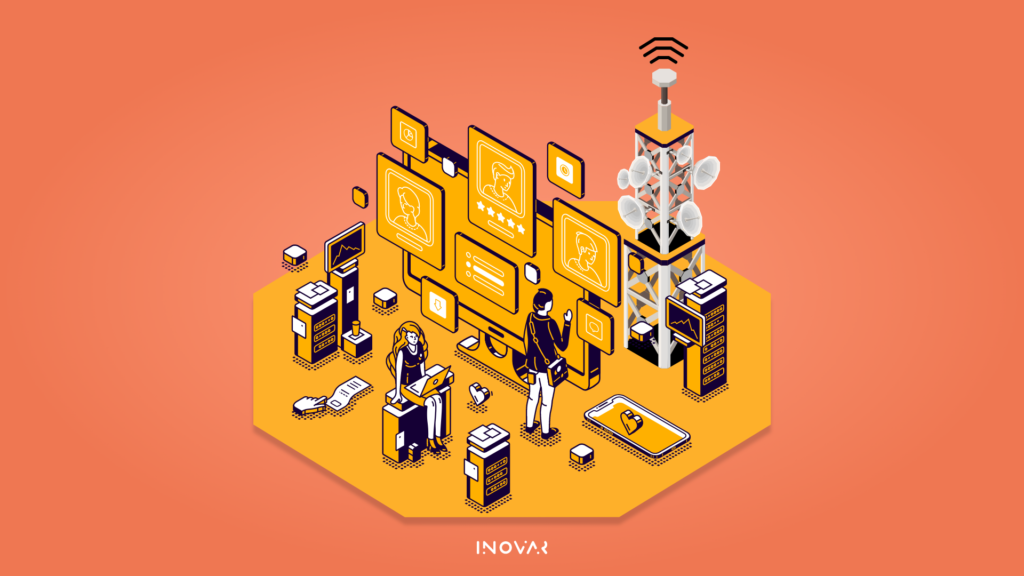
By implementing SharePoint Online telecom organizations can move a lot of their vital collaboration tools to the cloud, enabling peer networks to share problems and concerns, access a single content from a different point, and add value while on the move. With the offline access feature, all data automatically gets synchronized between SharePoint Online and local computers whenever a network connection is available.
SharePoint Online offers a real-time co-authoring feature to enable the stakeholders to collaborate in real-time.
Our proficiency in providing SharePoint solution
Our US telecom client was facing collaboration and communication issues due to an improper and interrupted operation. According to Shivsankar Barik, VP Delivery of Inovar Consulting, the main challenge was that our client’s organization had an issue in collaborating with peers and reaching out to the right SPOCs to find important information.
Our target was to provide them with an automated technical solution to ensure effortless operations and uninterrupted communication. We cut down their time to market and improved their operational efficiency with a 40% improvement in site/signal compliance achieved with the help of big data analytics and helped them migrate from SharePoint on-premise to SharePoint Online. The entire automated environment enriches the visualization and monitoring power in a network. It also provides real-time alerts to avoid any sudden failure.

“What started as workflow automation solution, resulted in huge cost savings optimizing end to end process”- Apratim Ghosh (CEO, Inovar Consulting).
We have come a long way since then having managed their existing SharePoint Sites, built net new sites for different teams. Data security and access control are other vital concerns of our clients. We deploy a hybrid cloud solution applying next-gen technology for controlling access with better data security.
Automated telecom infrastructure with a customer-centered, data-driven culture can drive profit, increase productivity and significantly reduce costs. If you are also looking for an automated technology solution to manage your telecom networking and communication systems feel free to reach out to us.
The pandemic has changed how people around the world live, work, and engage with each other. In late 2019 when covid-19 struck the world, affecting millions of people all over the planet — the healthcare industry was hit the most. The pressing need for resources, information, cost optimization, and supply chain inefficiencies in the sector calls for a major technology overhaul. Therefore, embracing new-age digital technologies is key for healthcare providers in addressing the immediate concerns and driving long-term goals.
Automation makes a revolutionary process change in most of the industries, that has the same or even more potential for the healthcare sector. Introduction of Business Process automation can streamline the healthcare system for simplicity, increase service quality, and manage pen and paper-based manual tasks, saving time and cost without the slightest glitch.
Challenges in Healthcare
Application Disparity: Modern healthcare is a complex environment where many disparate applications work. The complexities also grow with the business. With mergers and acquisitions, modern technologies are adopted to meet new challenges. In this situation managing all technology becomes quite difficult for the healthcare IT departments and business users.
For example, in most healthcare sectors, patient data transfer is still carried out manually in the form of files and documents from one department to another. As the volumes of data are generally high, compiling them in one single process is a tedious and lengthy process. Not to forget, since they are done manually, there is always scope for multiple human errors and miscalculations. The greater the rate of error, the more the cost will be for rectification.
Lack of efficiency in patient service is another challenge that can be a barrier to your organization’s growth and reputation. In most scenarios, customer care executives are busy with paper works and other files and documents compilation that they lack prompt and timely delivery of services to the customers.
I hope you can relate to the problems I discussed above. So now I am going to share how automation becomes an integral part to solve some of healthcare challenges.
The business automation software works on all programs whether, new applications, legacy programs, cloud-based solutions, or on-prem.
BPA makes human-oriented processes much smoother with greater results like increased speed, productivity, and efficiency. Suppose for a patient, scheduling an appointment with a doctor usually happens online in a matter of minutes, but what happens behind the scenes is a bit more complicated. Healthcare institutions have to collect personal information, diagnosis, insurance details, and confirm the doctor’s availability. If the right information cannot be accessed during the registration process, or if the doctor is not available, it is up to the staff to inform the patient beforehand.

Implementing automation can resolve some of the bottlenecks related to scheduling patient appointments. Bots can automate patient data collection and processing, so patients can be optimally scheduled according to diagnosis, location, doctor availability, and other criteria. By simplifying appointment scheduling, healthcare institutions can focus their efforts on providing exceptional service and other tasks that cannot be automated. Automation tools also enable customer care executives to take the assistance of such tools with automated call and email options.
Inovar proposed Automation Solutions with better ROI
Something similar also happened with one of our US healthcare clients. They were also facing customer support challenges during the pandemic. They were primarily using a pen and paper-based system for information collection and symptom analysis. After the outbreak of the virus, a lot of patients started asking for support in their chatbot regarding diagnosis, vaccination, and other medical support.
With a lot of restrictions, it becomes necessary to give patients the capability to run the assessments on their own from the comfort of their homes. Remote work capability also became especially important, and they needed an infrastructure through which they can achieve that.

To manage the entire scenario, they required VPN, which was not designed for such large-scale use resulting in low bandwidth and frequent outages. Additionally, a lot of the content and manual workflows required the physical presence of the employees on the hospital premises that was quite impossible at that moment.
In this critical situation, the first hurdle to cross was to get them to a cloud-based solution to ride care facilities across all their nation-level operations and provide the best health support to patients. This would make remote work possible for the hospital staff in case they were showing symptoms and had to quarantine at home.
In this situation, Inovar helped a leading US healthcare organization to automate their Covid-19 Helpdesk and Registration process from a pen and paper-based manual system to a cloud-based automated solution.
SharePoint Online became the choice of the platform along with Power Platform as their primary productivity technologies allowed them to create a technology framework with a built-in rapid growth mechanism and assist hospital staff to manage the entire remote work process.
With the implementation of the initial solution, the healthcare organization was also facing challenges to roll out the solution in all other locations of the US that becomes much fair with SharePoint and the power platform.

A simple but practical experience gained a high adoption rate within the healthcare organization. The organization’s IT team also considered it as the best rollout experience with almost a zero-touch provisioning and deployment strategy. Ultimately, with all these solutions 90% of their remote and quarantined caregivers were able to serve the patients over remote calls and Online consultation.
The digitization of call centers was a major bonus as it consisted of Automated Diagnosis for Covid, automatic decision-making capabilities, and other similar tools that ensured self-help services that were non-existent before. This resulted in a reduction of 70% in phone calls.
Businesses transitioning from manual processes to comprehensive workload automation tend to go through several phases on their automation journey. If you are also facing the same difficulties within your organization, then Inovar is the best partner to collaborate with and make your automation journey smoother. Feel free to reach out to us we would love to collaborate!
With every progressive step of technological advancements, the priorities of CIOs are also changing. Process transformation and automation have gained much of leaders’ attention in recent times. Automation, the use of machines to perform work, most commonly refers to using the use of computer technologies to perform the tasks humans would otherwise do as part of their jobs. The use of computer-based process automation is widespread, with organizations deploying a broad range of software automation tools to help them reach the automation goals they set as part of their larger digital transformation objectives.

According to the December 2020 Global Intelligent Automation (intelligence AI) Study from Deloitte, *73% of organizations worldwide use automation technologies. That’s a significant increase from the *58% of organizations using such technologies in 2019. Gartner reported that organizations’ interest in a process of transformation is accelerating, demand for robotic process automation (RPA) software witnessing the growth of **19.5% from 2020.
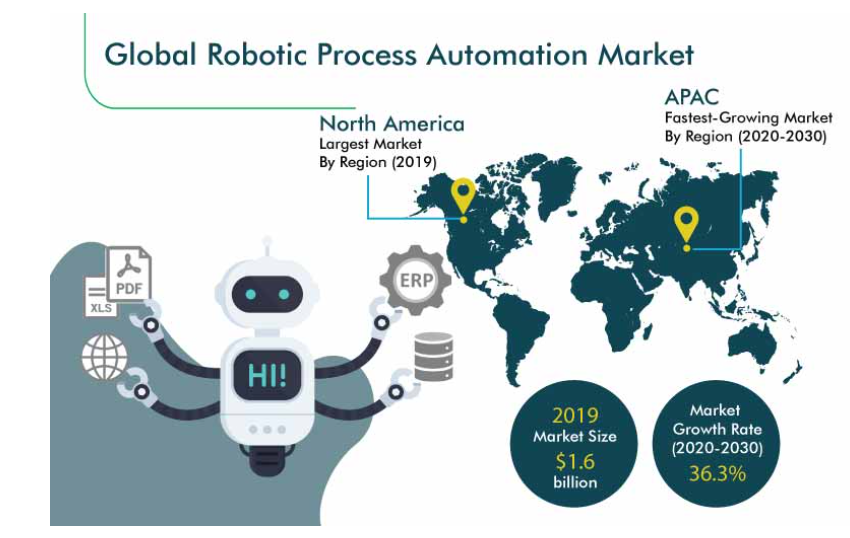
But, RPA is not the only process automation technology that companies are leveraging to drive goals, efficiency, and digital transformation. The diversified business sector embraces certain other automation options such as business process automation (BPA) and digital process automation (DPA). Each of the three technologies offers benefits, and each has distinctions that separate it from the others.
What is robotic process automation (RPA)?
RPA technology mimics the way humans interact with software via a UI to perform high-volume, repetitive tasks. The technology creates software programs, or bots, that can log in to applications, enter data, calculate, and complete tasks, and copy data between applications or workflows as required. But RPA doesn’t inherently have intelligence or decision-making capabilities. Hence, the work best suited to RPA is rules-based. These are discrete tasks done the same way over and over, with no deviations that require human decision-making. According to Gartner, RPA represents a major portion of the automation market. Experts believe that the primary benefits of RPA are increased efficiency, lower costs, and reduced errors. RPA bots can perform tasks faster and with consistent accuracy and reliability. They can work round-the-clock without taking breaks.
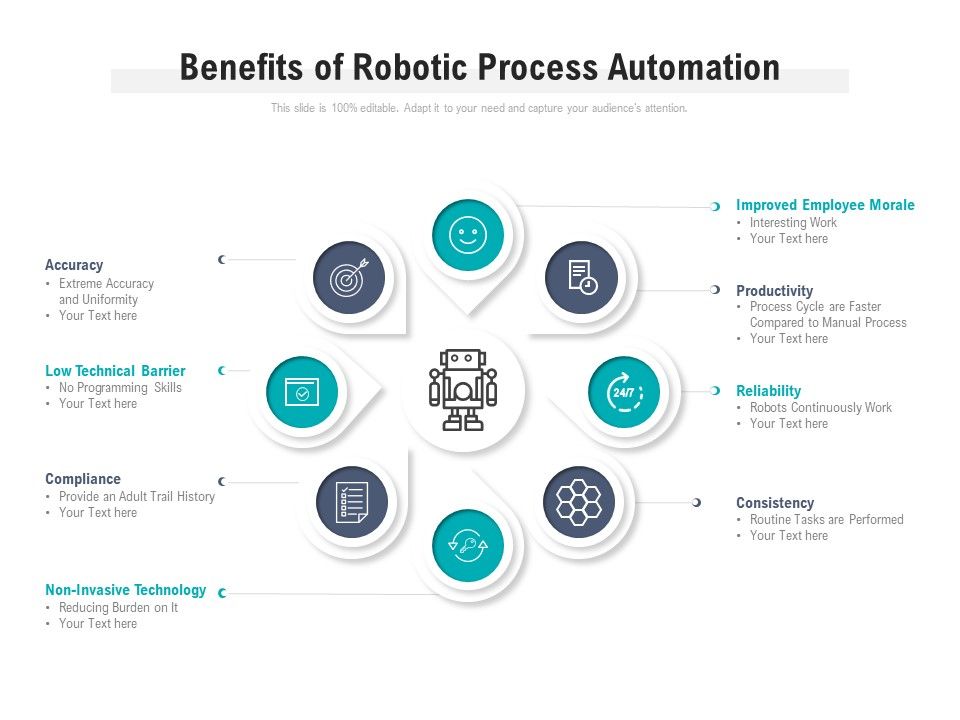
Another reason for RPA’s growing popularity in the enterprise is its relative ease of use. RPA works with an organization’s existing infrastructure and applications. Also, because many vendors offer low-code/no-code RPA platforms that require little to no programming experience, business users can harness RPA, creating their own bots with minimal help from their IT departments. As such, business users are driving much of the RPA adoption.
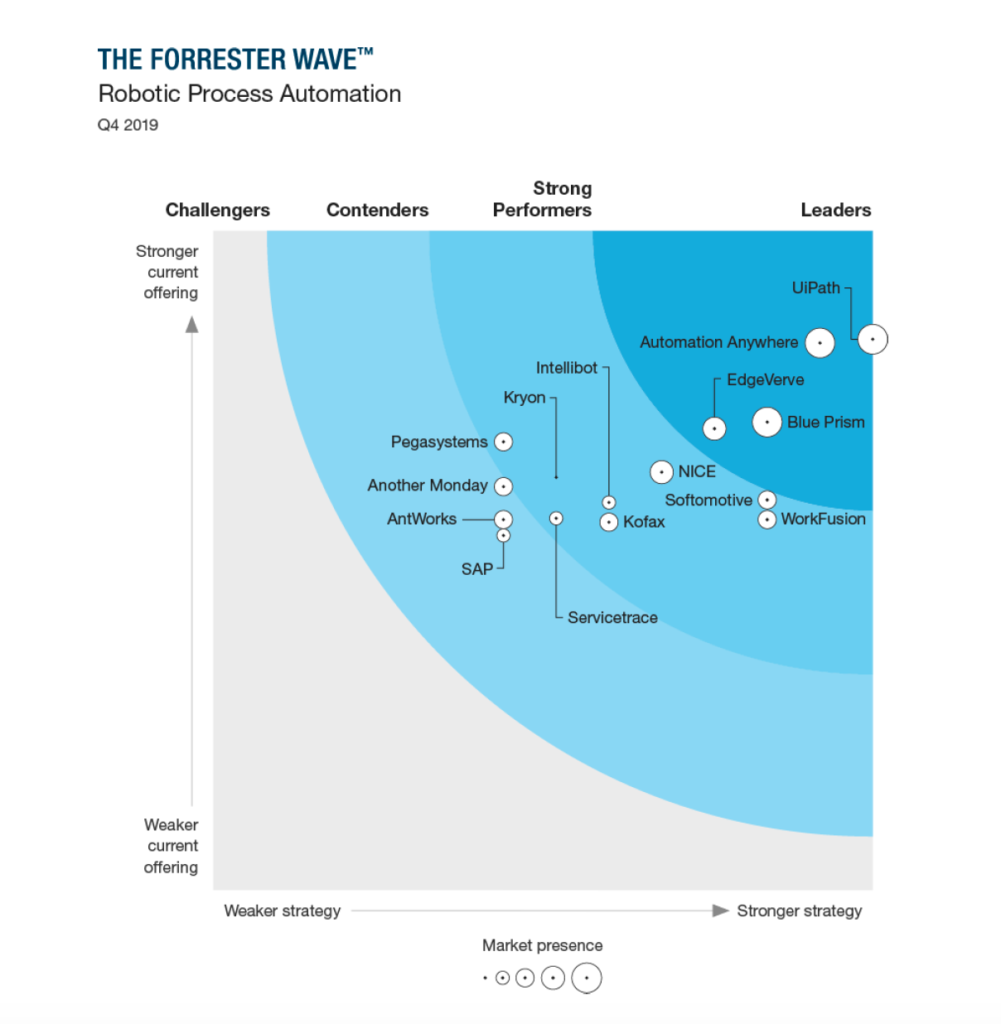
What is digital process automation (DPA)?
DPA is a software technology used to automate a process and optimize the workflow within an automated process. A big focus of DPA is to improve employee and customer experiences by taking friction out of the workflow. The software is used to create efficiencies and enhance UX experience in various areas of the enterprise, from IT service requests to onboarding new employees and client intake.

Organizations use DPA to automate a process from its beginning to its end. Typically, DPA is used for the longer and more complex processes than the tasks that can be effectively handled by RPA. These processes can contain multitudes of decisions that, if using RPA, would create bots that are too long and too difficult to maintain.
As per a ***Forrester schema, DPA is divided into two types: DPA-deep, and DPA-wide, which is closely related to RPA:
- DPA-deep is automation that transforms and improves a business process and, because of the complexity, requires skilled technologists to implement and focus on continuous
- business users and can be managed by the business and delivered using low-code platforms and Agile methods.
What is business process automation (BPA)?
BPA automates workflows within an organization; as one step in the business process is completed, the BPA software then automatically triggers the next step. BPA software is used to automate complex, multistep business processes that are usually unique to an organization and are part of the organization’s core business functions.

Size of the business process automation system (BPA) market worldwide from 2016 to 2021
BPA’s holistic approach stems from the technology’s capability to work across the multiple enterprise applications and systems required to complete a typical business process. Organizations often first analyze and improve a business process with a BPA approach before automating it, which is different from the mimic-as-is tactic typically used in RPA.

Reworked, optimized processes using BPA remove human hands from the workflow; with human workers no longer involved in the automated process, they’re not introducing individual workarounds or unauthorized changes to the workflow. Consequently, enterprises use BPA in their digital transformation efforts for the accuracy, efficiency, and reliability it brings to each automated process.
Experts Opinion on – RPA Vs BPA Vs DPA
Some experts use BPA as an umbrella term for a wide range of process automation technologies but there are varied opinions on that concern as well.
According to Gina Schaefer, intelligent automation lead at Deloitte Consulting LLP said- “DPA, BPA, and RPA — are practically interchangeable.”
She further added – “Digital, business process and robotic process automation are essentially the same. When applied appropriately, these refer to comprehensive end-to-end process automation. Specifically, these terms refer to the use of scripted automation software to mimic human actions in the execution of rules-based ‘swivel chair’ type tasks, typically where an individual accesses and processes data from multiple applications.”

InovarTech is ready to improve your automation experience. With our smart forms and streamlined workflows, you will be ready to tackle process technologies and know-how to adapt them to your institution. Reach out to us today to get started. You can take comfort in the fact that we know process automation and how to implement them effectively. Let us deliver high-volume processes to your doorstep.
Resources:
**– https://www.information-age.com/rpa-revenue-reach-nearly-2-billion-2021-gartner-123491711/
Jeanne W. Ross (MIT Sloan’s Center for Information Systems Research) says-
“Clearly, the thing that’s transforming is not the technology — the technology is transforming you.”
Staying relevant has never been difficult – difficult was, to be adapted to the rapid pace of innovation, drive by the number and variety of new technologies, and most importantly, step forward with the growing economic pressures after the global pandemic. From the “big bang” to the “e-commerce boom” we have surely come a long way. But now digital transformation is probably the real buzzword for e-commerce businesses and global industry leaders.
We could start this article with a definition of digital transformation and why it’s essential for running an e-commerce business in 2021, but that would be boring (as most people aware of digital transformation and its benefits) – so we won’t. Instead, we decide to focus on the two principal aspects—
- What are the driving forces behind the digital transformation in ecommerce?
- How will digital transformation drive the future of e-commerce?
Before we dive too deep into this topic, I think it’s valid that first answer the question:
How does COVID-19 affect e-commerce businesses?
The standardized lockdown rules across the globe and the growing hesitation among consumers to go outside and shop for essential goods have tilted the nation towards e-commerce. Consumers have switched from shops, supermarkets, and shopping malls to online portals for the purchase of products, ranging from basic commodities to branded goods. Since the norm of social distancing has been initiated scope of online purchases and online businesses skyrocket. Many people have embraced the concept of online retail, and the surge in FTUs (First Time Users) on e-commerce sites is visible.
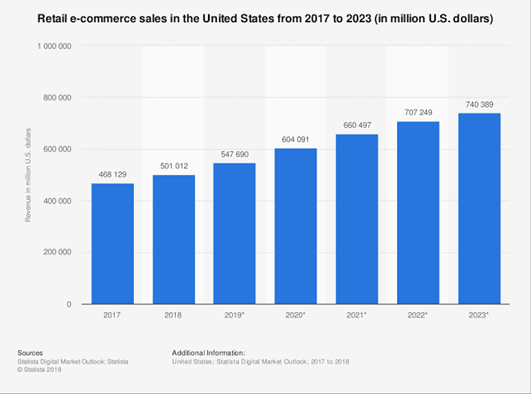
(Source: Statista.com)
As per the statista report, the market opportunities for online commerce in world are expected to touch $740 billion by 2023 from $468 billion in 2017. Based on the data available, the growth in the countries like Indian, Philippines, Malaysia are going to beat other established markets like US, Mexico, China by 2034.
On the downside of things, lack of productivity during the nationwide lockdown resulted in the loss of jobs, pay cuts, and finances. Shutting down shops and family-based businesses has made many people sway towards online retail to meet their financial requirements.
In that situation, digital transformation isn’t jargon extracted from a pretentious keynote speech, it becomes an essential part of staying in business. Now, B2B and B2C companies compete against their online rivals to take a slice of the e-commerce pie, and companies who don’t keep up quickly go bust. The above facts work as a catalyst behind the adoption of digital transformation strategies in e-commerce.
The driving force behind the digital transformation
1. Shoppers are looking for new products online
According to salesforce, 87% of shoppers look for product information and helpful reviews online — even if they plan to make their final purchases in a brick-and-mortar store. Consumers always expect to find up-to-date information and brand contact information quickly and easily.

2. Consumer expectations continue to rise
Modern consumers are now expecting to personalize experience across a range of channels. Have you heard of Omnichannel Marketing? People are enjoying apps and hope their shopping basket to travel from device to device. Hence, you need to cater to your customer base to grow your bottom line.
3. A robust online presence of brand to show value
The majority of growing brands now choose direct-to-consumer, rather than wholesale marketing strategies. The main point behind this: cut out the middleman and make more profit, and consumers get to communicate directly with brand manufacturers. Strong online presence and robust branding are the primary weapons to create a roadmap for success in that type of marketplace.
Now, you have enough reasons to implement digital transformations on the e-commerce platform. But reasons aren’t enough, you also need to know how to implement digital initiatives in your every business touchpoint. Below we describe in detail the digital trends, which will make your work much easier.
How digital transformation will shape the future trends of e-commerce.
Digital transformation does not have an endpoint, so you won’t have a chance to sit back, dust off your hands, and say, “Right— that’s it.”
Keeping up a digital vision and mindset is the most vital aspect of your organization’s digital transformation. Hence, you should keep a track of your customer expectations to modify your tactics and meet the need of your customer demographic. Instead of worrying many entrepreneurs try to approach change management with a sense of adventure and opportunity so that they can invest in new business processes and reap significant rewards. Let’s look at the principal ways of digital transformation change in e-commerce in the coming future.
1. Technology in the frontline
Only the will to achieve digital transformation is not enough. E-commerce sectors need to acquire and successfully deploy the right technology if their efforts are not to be in vain. To achieve success, e-commerce industry should improvise their IT infrastructure and software — management and maintenance skills must also be in place. Skill shortage in the IT part means rather than looking inward, B2B companies are increasingly having to explore possibilities outside the enterprise for technology provision. This puts a greater emphasis on cloud-based infrastructure and solutions, managed services, and automation.
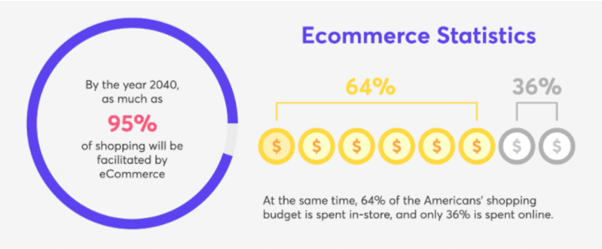
(Source: centerity.com)
Automation is not necessarily direct AI-related technology — is a necessary step in the development and delivery of digital transformation for e-commerce at this stage. Some widely using automation processes are natural language processing (NLP), and cognitive automation, robotic process automation in conjunction with AI, and others. Here I want to highlight the top five ways to leverage automation for e-commerce business—
- Using the modern email marketing strategy, a brand can easily build automated workflows that schedule messages based on user activity or important dates. For example, the “Abandoned Cart Saver” engine works on a 100 percent automated basis.
- An online business can also automate the collection of customer feedback without any first-hand involvement.
- Inventory management is one of the tedious aspects of e-commerce that can simplify with automated accounting software- such as keeping track of purchase orders, updating the number of products in stock, or calculating the real-time valuation of your inventory.
- Automated invoicing is another essential aspect.
- Now, a business can also develop a chatbot with the help of AI without writing a single line of code.
2. Significance of big data and analytics in enhancing personalization
Big data is one of the substantial parts of e-commerce digital transformation. Giant retailers use this technology to provide consumers with highly personalize shopping experiences.
You know how they make this magic?
Online giants are using machine learning to modify site algorithms based on previous consumer activity because they recognize that familiarity boosts the bottom-line. May in the future, it will be easier for people to opt-out of personalization. But, for now, companies continue to push personalization on the Internet of Things (IoT) devices, like thermostats, doorbells, and artificial intelligence (AI) tech (think Amazon Alexa or Siri). With all these approaches, data is becoming a larger and larger component – and therefore a challenge – for many organizations.
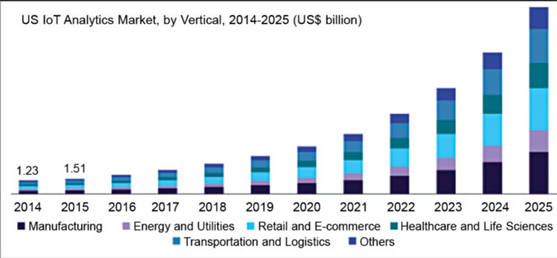
(source: iot.electronicsforu.com)
Data analytics initiatives require a clear understanding of the objectives they’re put in place to achieve and the resources available to implement them. Stakeholder and user requirements may influence the selection of software and services. Hence, the business should choose their technology or solution partners with these considerations in mind.
3. Cloud to cater to the changing market demand
There is myriad of advantages e-commerce is drawing from cloud computing today. Most importantly, cloud in e-commerce enables the business to look big virtually and operate extensively. To make it clear, I want to highlight four crucial aspects:
- Cloud computing qualifies e-commerce applications to cater to the changing demand and scenarios of the market. It allows to upscale or downscale the online services based on demands, traffic, and seasonal spikes.
- For an e-commerce business, speed plays an important role to keep customers glued, and cloud computing provides you with greater bandwidth, computational power, and storage.
- With the cloud-native technology, strategy e-commerce can cut down the costs of developing and maintaining IT infrastructure.
- At the time of catastrophic data losses or security threats, redundancy is significant to overcome the disaster and resume business streamline. A cloud-based platform with built-in redundancy can save a business from data loss.
4. Headless and API-driven strategy continued innovation
We have a ton of favorite sites, but do we have any idea how those sites work? We hope online at free time, fulfill our midnight cravings, and go back to work. Behind the scenes – our order preferences travel faster than the speed of sound through a headless commerce system and file neatly into its database.
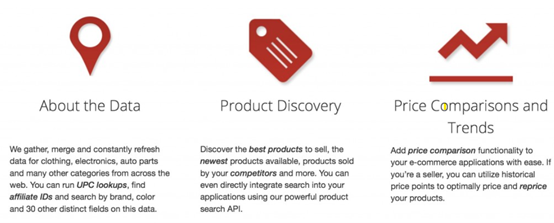
(Source: ecommerceinsiders.com)
In a nutshell, headless commerce decouples a company’s e-commerce platform from its frontend. When uncoupled, any data entered a website’s backend travel seamlessly to a range of frontends via application programming interfaces (APIs) — for example, progressive web apps (PWAs) and content management systems (CMSs). In order to leverage these techniques, companies add content to a compatible backend and couple on APIs – or customized frontend (like reaction button). Is it sounds too complex?
Check out few additional reasons behind use headless commerce:
Flexibility: Headless commerce is SEO friendly, and it is flexible and agile across a range of devices.
Personalization and customization: Businesses can control the consumer experience from start to finish by using a headless commerce tech stack, streaming data from one central database to a collection of APIs.
5. Content and digital web presence
Content and the creation of brand narratives can boost the processes of building a stronger digital presence while fostering brand recognition.
Content and storytelling can help reach customers and create more brand loyalty, as well as establish companies as thought leaders and experts in their field. Through a clear content program, a brand can drive product offerings with a briefing on necessary aspects and influence purchasing decisions of customers. This is an area where manufacturers and distributors need to incorporate a broader Customer Insight/experience strategy to maximize outcomes and increase revenue.
Digital web presence is often how customers experience the brand for the first time. This is also a route for improving customer experience and increase website conversion rate. According to a statistic, most consumers leave a website if it takes more than 3 seconds to load. Digital UX and UI is playing an important role to help users navigate through the website, find their requirements, and develop a trustworthy connection with the brand. Many organizations are still developing and improving the functionality of their websites and eCommerce platforms, both on the user and internal sides. Websites can drive additional growth and revenue – but they can also play a role in capturing more data, sourcing out leads, and boosting customer engagement.
6. Digital transformation at an organization level
Digital transformation is moving beyond eCommerce and marketing, to embrace the organization. It’s looking at what leadership is involved in decision making, undergoing internal process changes, and even creating new job responsibilities and titles.
New recruitment practices for digital transformation are seeking out software engineers, user experience experts, and data scientists to acquire the needed skill sets and embed the right innovation mindset across the board.
Apart from that increasing mobile shopping experience, the wide spreading of alternative payment methods, direct to consumer strategies are accelerating the digital revolution in the e-commerce industry. From understanding how buyers make decisions (and who those decision-makers are) to opportunities for more personalized content and messaging in all funnels, digital transformation technologies and data management help enable more effective e-commerce business techniques. Now, this is the time to align all business digital touchpoints with business goals, and digital strategy consulting companies are here to help you navigate through all these digital strategies. For more information and consultation feel free to reach to digital consulting service company Inovar Consulting.